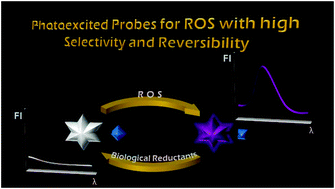Photoexcited molecular probes for selective and revertible imaging of cellular reactive oxygen species
Abstract
Redox homeostasis is key to maintaining the normal physiological status of living cells. The redox state of cells is primarily a consequence of the precise balance between levels of reactive oxygen species (ROS) and biological reductants. Optical imaging has become one of the most preferred methods for biological sensing in complicated systems, due to its easy operation, good selectivity, and superior sensitivity. The development of optical tools to trace and label ROS is a formidable and challenging task due to the high reactivity, short lifetimes, and extremely low concentrations of ROS. In recent advances, probes that serve as ‘modulators’ for labeling fluctuation change of ROS levels, rather than imaging the transient ROS bursts, have been widely reported. Classic examples of probes for selectively and revertibly imaging cellular ROS, including fluorescent, phosphorescent, and photoacoustic probes, are summarized and several possible future directions in this field are discussed in this review. The advanced probes can provide a powerful tool to study redox homeostasis between a specific ROS and biological reductants, and may establish foundations for biomedical research on dynamic real-time monitoring of ROS in living systems.

- This article is part of the themed collection: 2021 Organic Chemistry Frontiers Review-type Articles


 Please wait while we load your content...
Please wait while we load your content...